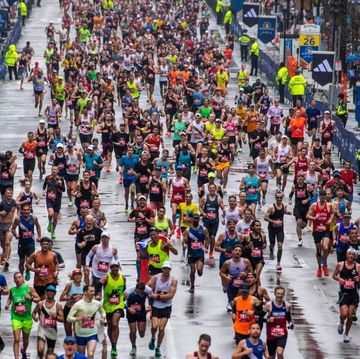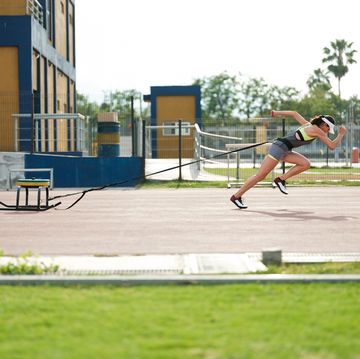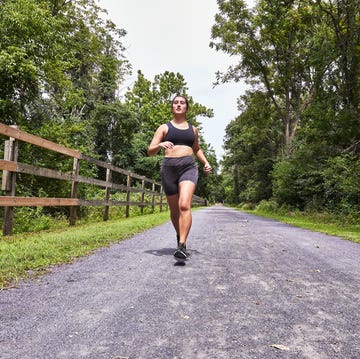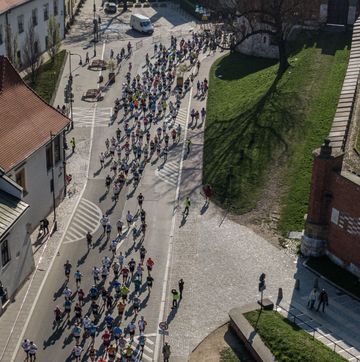Evan Jager glances up at the video board with about a quarter mile remaining. He's leading the fast heat of the mile at the Husky Classic in Seattle, and he can see a string of runners shooting off the turn behind him. Grimaces have crept over their faces in the last lap. His face, however, remains relaxed, jaw hanging slack.
With each bouncy stride, Jager's long blond hair explodes straight up, then collapses over his white headband. At a more relaxed pace, his long spindly legs can't quite uncoil. The effect is one of contained speed. In this full-flight sprint of a closing lap, though, they unfold completely and gobble up huge stretches of track. Those legs are one reason that his best event is now the 3,000m steeplechase: By the time he begins whipping his trail leg over a barrier, his lead foot is almost on the track, ready for the next stride.
The din that has filled the University of Washington's indoor track all day swells to a roar. Kids and parents and coaches press up against the inside lane, urging the runners on.
Jager and two others, training partner Andrew Bumbalough and Olympian Donn Cabral, charge into the final lap with a dozen collegians trailing. While others fight the fatigue of the escalating pace, Jager floats ahead. With 50m to go, he remains in control. Then, in the final strides, Bumbalough -- appearing to work twice as hard -- inches ahead to win.
Despite the loss, Jager has opened his 2013 campaign with the third-fastest mile in the world -- 3:56.14 -- by running the final quarter mile in 55 seconds.
"I'm definitely fitter at this point of the year than I've ever been," Jager, 24, says. Coming off a historic steeplechase debut season in which he set an American record and placed sixth at the Olympics, his confidence suggests the possibility of more great things to come.
The next day, Jager is relaxing at home in Portland, Ore. He and his housemate Elliott Heath ran 90 minutes around the nearby Nike campus in the morning. Now Heath and their other housemates, Chris Derrick and German Fernandez, have vanished for afternoon naps. Nestled in a corner of a black leather sofa in the living room, Jager reflects on his decision to leave the University of Wisconsin after his freshman year. His coach, Jerry Schumacher, was moving to Portland to put together a professional training group and asked Jager to join him.
"Why not get a head start," Schumacher said to him in the spring of 2008. "Get a four-year jump on your peers." Jager knew immediately that he wanted to go.
"He had to tolerate going to classes so he could run in college," Joel Jager, Evan's father, says later. "He didn't articulate that, but that was apparent to a lot of us." Jager's parents supported his move but wanted him to continue his education, so Jager is studying exercise science part-time at Portland State University and could graduate next spring. "It's always hanging over my head, and I just want it to be over," he says. "School is a distraction from being the best athlete I can be."
Jager cycles through a series of distracted tics while he talks. He twirls his hair around a finger, then snaps a bracelet on and off his right wrist. He fiddles with an earring and flips through screens on his phone. ESPN plays constantly in the background. One NBA game gives way to another.
Jumping to the pros would be a bold move for any 19-year-old. Jager had run just 35 to 40 miles a week in high school, and a year later he was trying to keep up with Chris Solinsky, Matt Tegenkamp, Tim Nelson, Simon Bairu and Jonathon Riley for 70 to 80 miles a week. "I was always exhausted," he says of late 2008 and early 2009. "I just didn't know how far behind I was. I was very, very raw." For months he struggled to complete workouts.
"If he did three-quarters of the work, then it was a big day," Tegenkamp says. "There was an expectation that he was never really supposed to finish the workouts -- but Jerry never told him that."
Finally, one March day, he kept up. The group drove from an altitude camp in Flagstaff, Ariz., down to Sedona to run a set of fast 400m repeats. Solinsky finished eight of them, Tegenkamp 12. Jager completed 10.
"What's up! I'm ready to make the team!" he remembers thinking. He smiles at the memory. At the U.S. championships that summer, the three swept the 5,000m and headed to Europe together to run in the world championships.
When Jager describes the year that followed, he grasps his toes in one hand and gently cracks the knuckles. Surgery on a fractured right navicular -- a bone on the top of the foot -- wiped out his 2010 season. He had broken his left navicular in high school. Though Jager and Schumacher had independently considered the steeplechase, the injury gave them pause. Schumacher wanted him to train for a year without getting hurt. A healthy 2011, which included a near-PR of 3:38.80 in the 1500m, set Jager up for the transition.
The steeplechase occupies an odd niche in the track and field world. It's rooted in cross-country horse racing, in which competitors leap fences and splash across streams. Standardized for the track, that mayhem involves 35 sturdy 3-foot-tall barriers spread over 3,000m, seven of them leading into a water pit. The water stretches for 12 feet, just beyond most athletes' leaping ability. Competitors approach the barriers in an unruly pack, spiked feet flying out and elbows flailing with each leap. The event demands a level of coordination and recklessness not often associated with distance running.
It's rare for the best American distance runners to try the steeplechase. The three runners who dominated the event from the late 1970s through the late 1990s, Henry Marsh, Brian Diemer and Mark Croghan, still own 23 of the 30 fastest U.S. times ever, yet none of them ever ranked in the top 10 in the mile or 5,000m. Jager accomplished that feat as a 20-year-old.
In October 2011, Pascal Dobert quietly began preparing Jager for the new event. Dobert, an 8:15 steepler in his prime, manages the supplementary training of Schumacher's athletes. Jager began with a couple of weeks of flexibility and standing drills, then he began hurdling. In December he ran a set of 400s over hurdles and felt great. "There's a lot of different elements to [the steeple]," Dobert says. "Evan was like A+, A+, A+ right off the bat." He rattles off a list of traits that suit Jager to the event: athleticism, quick feet, spatial awareness, springy stride, height (he's 6 feet 2 inches tall). "On paper, he's perfect," Dobert says.
Joel Jager was one of the few outside the camp who knew of this training. "They were pretty secretive about it," he says. "I wouldn't say we were sworn to secrecy, but they didn't want it on Letsrun.com." He chuckles at the memory.
"I wish I could say I was excited," Cabral, the 2012 NCAA champ and Olympic finalist, says of his initial reaction to Jager changing events. "But the first thing I thought was, 'No! Stay out of this. You're too good at the 5K. I don't want to see what you can do running against me in the steeplechase.'"
Jager alternated workouts for much of the year. One week he ran with the 5,000m guys, the next he ran a solo steeple workout. He progressed rapidly, winning his debut in 8:26.14, just two weeks after his first attempts over a water jump. In his next race, he took the lead over Dan Huling and Cabral going into the final water jump but missed the barrier and crashed into the pit. He still ran 8:20.90.
"When I saw that, I was like, 'You're way better at this than I thought,'" Joel Jager says. He called Schumacher and asked if the Olympics were a possibility. "I think we can count on it," he recalls the coach telling him. Jager's parents booked a flight to London after his second career steeplechase.
Expectations shifted with each workout and race. Jager would finish a grueling session and ask how it translated to race fitness. "I wasn't totally honest," Dobert admits. "I didn't want to give him a big head or make him overconfident." Just a couple of months earlier, sub-8:20 had seemed like a good goal for the season. Following a pre-trials workout, Schumacher and Dobert realized their novice steepler was already in sub-8:10 shape. After winning the Olympic trials in another PR, 8:17.40, Jager flew to Europe.
His one chance to run fast came at the Monaco Diamond League meet on July 20. He methodically worked his way through the field. At the bell, he surged alongside the world junior champ, Conselus Kipruto. Though Kipruto pulled away, Jager ran 8:06.81. He had broken Daniel Lincoln's American record by more than 2 seconds, in his fifth steeplechase. Going into London, Jager thought he had an outside shot at a medal.
Unlike Monaco, the Olympic final started slowly. The athletes hurdled in a tight, dangerous bunch. Jager and Cabral stayed out of trouble by leading the middle laps. At the bell, Jager seemed perfectly positioned in fourth. Then the Kenyan team struck, and Ezekiel Kemboi sprinted away with a 57-second last lap. Jager closed in 61 seconds and finished sixth, but he was never in contention after the real racing began.
"We didn't do anything that would've prepared me to do that on the international level," Jager says. "So that's something that we're going to do -- get me nice and tired and try to close in 56, 57 seconds over barriers." If he can learn to respond to that sort of surge, he could contend for a medal at the Moscow world championships in August. Sub-8:00 is another goal. Only 11 athletes -- 10 Kenyan-born and one Moroccan -- have ever run that fast.
If Jager qualifies for Moscow, he could have plenty of company from Portland. Schumacher's group has expanded greatly in the past year, with high-profile arrivals like Derrick, Fernandez and Alan Webb. Lopez Lomong set an indoor American record at 5,000m. Huling's arrival gives Jager a new workout partner, and Heath is also giving the event a try. Entering his sixth year as a pro, Jager is now surrounded by perhaps the most talented training group in the country.
Jager can too easily be written off as a goofy kid. His boyish face and backward-cap style make him look even younger than 24. Yet he exhibits a singular focus. Tegenkamp cites the maturity he showed even as a 19-year-old struggling to adjust to pro life. Dobert mentions his unflappable nature in competition, another trait that suits him for the steeple.
"You should know that he started walking at 9 months," his mother, Cathy Jager, says. By 16 months, he was wearing out his mother by sprinting endless laps around the family's house. Soon he was burning that energy by chasing a soccer ball to all corners of the field. Then it was racing his friends around a local rink on Rollerblades on Saturday nights. By high school, Jager says, "I recall telling people if I could do anything for a living it would be to run professionally -- but I don't think I knew what that meant."
Now that he's figured out what it means, he appears content with the routine. "I'm a very laid-back person," he says. "I love the lifestyle." He jokes that he's the old man of the house: "First to bed, first up."
When Jager, Derrick, Fernandez and Heath are in town, they battle on Xbox and grill on their back porch, looking out over residential southwest Portland. Their entire front room is devoted to a pop-a-shot basketball game. But they're often on the road for races or training -- Colorado Springs last winter, Mammoth Lakes in the spring.
Six days after the Husky Classic, Jager flies to New York for the Millrose Games. The 2-mile is billed as an American record attempt for Bernard Lagat, but Jager tries his best to spoil that. The two men are separated by 15 years in age and 6 inches in height, yet they share the same fluidity. Even on the tight indoor turns, Jager matches Lagat's easy strides lap after lap. The two pull away from the field, neither betraying the effort of the near-4-minute pace.
With 500m to go, an imperceptible uptick in Lagat's turnover leaves Jager alone in second. On the final lap, Bumbalough passes him. Then Cam Levins catches him at the line. He finishes in 8:14.95. Becoming the fourth-fastest American ever indoors is little consolation. His reaction later that evening is a simple, deadpan, "I'm a little pissed."
"He's never happier than when he wins," Cathy Jager says. "Not winning -- I won't even call it losing because he can have a spectacular race -- but not winning, in his mind it's like, 'If I'm not winning, there's still work to do.'"
Marc Chalufour, a former managing editor of Running Times, is the senior editor of AMC Outdoors.
MORE STEEPLE:
Read a profile of Donn Cabral, who finished second to Evan Jager in the 2012 U.S. Track and Field Championships and eighth in the Olympic final and has recently returned to Connecticut to train with his high school coach.
Learn how tough steeplechasers can be in the story of Brian Basili, a Villanova runner who last April fell on a hurdle and fractured his arm but still finished the race and won his heat.













